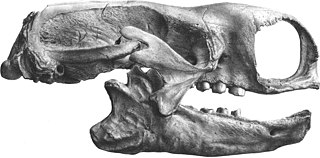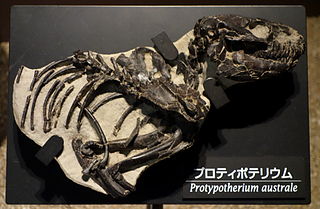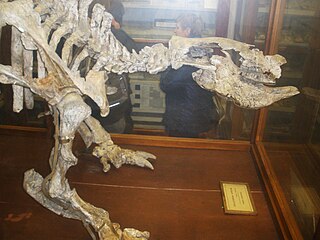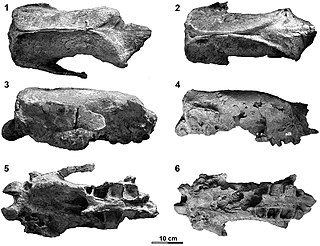
Megatherium is an extinct genus of ground sloths endemic to South America that lived from the Early Pliocene through the end of the Late Pleistocene. It is best known for the elephant-sized type species Megatherium americanum, primarily known from the Pampas, but ranging southwards to northernmost Patagonia and northwards to southern Bolivia during the late Middle Pleistocene and Late Pleistocene. Various other species belonging to the subgenus Pseudomegatherium ranging in size comparable to considerably smaller than M. americanum are known from the Andean region.

Mylodon is an extinct genus of ground sloth belonging to the family Mylodontidae, known from southern South America. With a total length of 3 to 4 m and a body mass of 1-2 tonnes, it is one of the largest mylodontids.

Hapalops is an extinct genus of ground sloth from the Early to Late Miocene of Brazil, Bolivia, Colombia, and Argentina in South America.

Theosodon is an extinct genus of litoptern mammal from the Early to Middle Miocene of South America.

Protypotherium is an extinct genus of notoungulate mammals native to South America during the Oligocene and Miocene epochs. A number of closely related animals date back further, to the Eocene. Fossils of Protypotherium have been found in the Deseadan Fray Bentos Formation of Uruguay, Muyu Huasi and Nazareno Formations of Bolivia, Cura-Mallín and Río Frías Formations of Chile, and Santa Cruz, Salicas, Ituzaingó, Aisol, Cerro Azul, Cerro Bandera, Cerro Boleadoras, Chichinales, Sarmiento and Collón Curá Formations of Argentina.

Glossotherium is an extinct genus of large mylodontid ground sloths of the subfamily Mylodontinae. It represents one of the best-known members of the family, along with Mylodon and Paramylodon. Reconstructed animals were between 3 and 4 metres long and possibly weighed up to 1,002.6–1,500 kg. The majority of finds of Glossotherium date from the Middle and Upper Pleistocene, around 300,000 to 10,000 years ago, with a few dating older, as far back Pliocene, about 3.3-3 million years ago. The range included large parts of South America, east of the Andes roughly from latitude 20 to 40 degrees south, leaving out the Amazon Basin in the north. In western South America, finds are also documented north of the equator. The animals largely inhabited the open landscapes of the Pampas and northern savanna regions.

Thalassocnus is an extinct genus of semiaquatic ground sloths from the Miocene and Pliocene of the Pacific South American coast. It is monotypic within the subfamily Thalassocninae. The five species—T. antiquus, T. natans, T. littoralis, T. carolomartini, and T. yuacensis—represent a chronospecies, a population gradually adapting to marine life in one direct lineage. They are the only known aquatic sloths, but they may have also been adapted to a terrestrial lifestyle. They have been found in the Pisco Formation of Peru, the Tafna Formation of Argentina, and the Bahía Inglesa, Coquimbo, and Horcón formations of Chile. Thalassocninae has been placed in both the families Megatheriidae and Nothrotheriidae.

Paramylodon is an extinct genus of ground sloth of the family Mylodontidae endemic to North America during the Pliocene through Pleistocene epochs, living from around ~4.9 Mya–12,000 years ago.

Scelidodon is an extinct genus of South American ground sloths. Its remains have been found in the Yupoí and Uspara Formations of Argentina, the Ulloma, Umala, Ñuapua and Tarija Formations of Bolivia, in Brazil, in Chile and in Peru. The youngest fossils have been dated to as recently as 9000 B.P.

Nematherium is an extinct genus of ground sloth belonging to Mylodontoidea, it is either considered to be a member of Mylodontidae or Scelidotheriidae. It lived during the Middle Miocene epoch (Santacrucian). Fossils have been found in the Cura-Mallín Formation of Chile and the Santa Cruz and Sarmiento Formations of Argentina.
Kelenkura is an extinct genus of heavily armored mammals belonging to the subfamily Glyptodontinae, from the family Chlamyphoridae that contain most of the modern armadillos. It was a medium-sized South American animal, distantly related to Doedicurus. Fossils of this genus were recovered in the Arroyo Chasicó Formation and in the Loma de Las Tapias Formation of Argentina in rocks dating back to the Late Miocene epoch.
Epipeltephilus is an extinct genus of armadillo, belonging to the family Peltephilidae, the "horned armadillos", whose most famous relative was Peltephilus. Epipeltephilus is the last known member of its family, becoming extinct during the Chasicoan period. It was found in the Rio Mayo Formation and the Arroyo Chasicó Formation of Argentina, and in northern Chile.

Megatheriinae is a subfamily of the Megatheriidae, an extinct family of ground sloths that lived from the Middle Miocene to the Early Holocene.

Pseudoprepotherium is an extinct genus of sloths of the family Mylodontidae. It was widespread across northern South America during the Early to Late Miocene epoch around 21 to 5.3 million years ago. Fossils of the animal have been found in Brazil, Venezuela, and Peru. Pseudoprepotherium lived in a tropical climate with a water-rich environment. Their known remains are limited to limb bones, except for a few skulls and teeth. Based on these remains, they were most likely medium to large-sized mylodontid. The genus was described in 1961 and currently contains three species, which were originally assigned to the genus Prepotherium.
Megathericulus is an extinct genus of ground sloths in the Megatheriidae family. It lived during the Middle Miocene, 11-16 Ma in what is now South America. Fossils have been found principally in Argentina, Bolivia, and Peru. It is a smaller representative of the megatheres. Despite being one of the earliest-known members of the family, its dentition structure is associated with homodont teeth belonging to the more modern line of evolution. The genus was scientifically named in 1904. Only one species is currently recognized, Megathericulus patagonicus.

Proeremotherium is an extinct genus of megatheriine ground sloths in the family Megatheriidae. It lived during the Late Miocene and Early Pliocene of what is now Venezuela. So far, two largely complete skulls have been recovered in the Falcón Basin in Venezuela. The finds identify the animals as medium-sized representatives of the Megatheriidae. In the cranial anatomy, Proeremotherium resembles the later and giant Eremotherium. It is therefore assumed that the two ground sloths are directly related to each other.
Archaeomylodon is an extinct genus of mylodontine ground sloths that lived during the Middle Pleistocene of what is now Argentina. It is known so far only from a single skull, which in its dimensions corresponds to those of the giant Lestodon. However, the skull differs from this one by its narrower and higher snout. In addition, the anterior canine teeth, which are usually large in many mylodonts, are greatly reduced. The find comes from the Pampa region of South America and was deposited in about 700,000 years old sediments.
Simomylodon is an extinct genus of ground sloths from the family Mylodontidae. It lived from the Late Miocene to the Middle Pliocene of what is now Bolivia and Argentina, 5.3 to 2.8 million years ago. The most important find material comes from the central Altiplano in Bolivia and includes several skulls and dentition remains. Thus, the so far documented body skeleton is the best known and most significant of a Miocene representative of the Mylodontidae. On the basis of the remains, it can be concluded that it is a rather small member of the Mylodontidae. The construction of the limbs supports ground-dwelling locomotion, but this does not exclude occasional digging or climbing. The type and only known species is Simomylodon uccasamamensis.
Analcitherium is an extinct genus of scelidotheriid sloth that lived during the Early Miocene in what is now Argentina. Fossils have been found in the Santa Cruz Formation of Argentina.
Rosendo is an extinct genus of notohippid notoungulates that lived during the Early Oligocene in what is now Argentina and Chile. Fossils of this genus have been found in the Sarmiento Formation and the Abanico Formations of Argentina and Chile.













